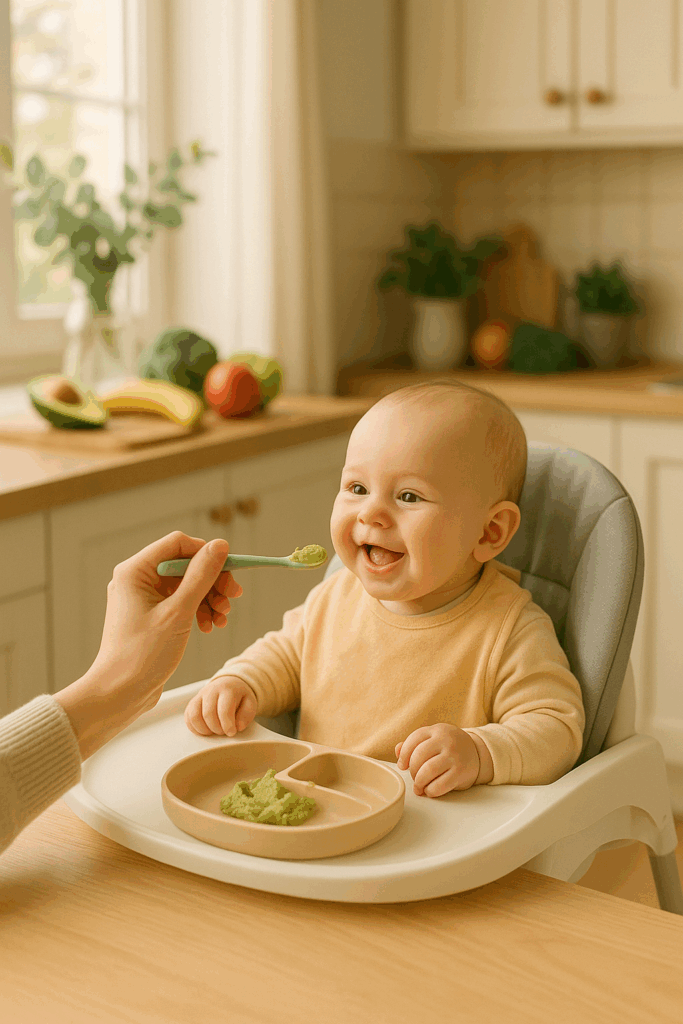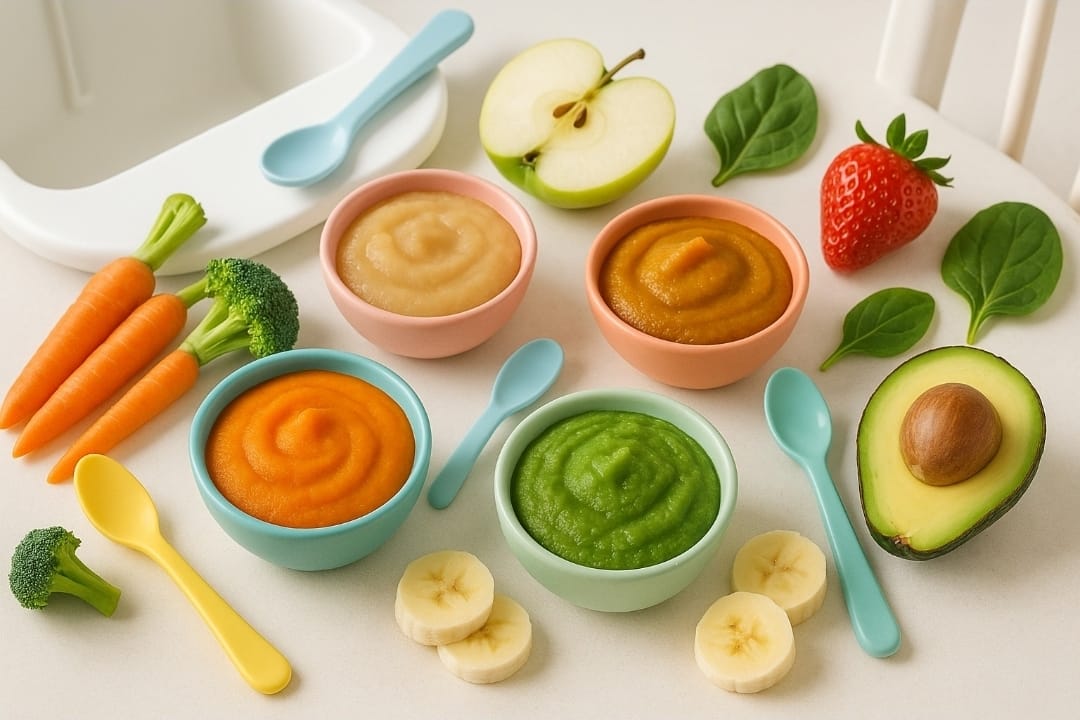Baby & Toddler Feeding can feel overwhelming, but with the right guidance, you can make mealtime enjoyable, nutritious, and stress-free. In this guide, we cover introducing solid foods, age-appropriate meals, healthy snacks for toddlers, handling picky eating, and recommended high chairs and feeding tools.
Table of Contents

1. How to Start Introducing Food to Your Baby
Introducing solids is an exciting milestone. Most babies are ready around 6 months, showing signs like sitting up with support, showing interest in food, and losing the tongue-thrust reflex.
Step-by-Step Introduction
- Start simple: Single-ingredient purees such as mashed avocado, banana, or sweet potato.
- Introduce one food at a time: Wait 3-5 days before adding a new food to monitor for allergies.
- Textures: Begin with smooth purees and gradually move to thicker mashed foods.
- Mealtime routine: Pick a quiet time, preferably when your baby is hungry but not overtired.
Age-Appropriate Foods
- 6–8 months: Mashed fruits, cooked vegetables, rice cereal, plain yogurt.
- 8–10 months: Soft finger foods like small pasta, scrambled eggs, soft fruit chunks.
- 10–12 months: Small pieces of cooked meat, cheese cubes, bread, soft veggies.
- 12 months+: Most table foods (cut into small, safe pieces).
What to Avoid Feeding Babies and Toddlers (0–3 Years)
0–6 months
- Only breast milk or infant formula — no water, juice, or solid foods.
- Avoid adding cereal to bottles; it can cause choking and overfeeding.
- Do not give cow’s milk — babies’ kidneys can’t handle it yet.
6–12 months
- No honey — risk of infant botulism.
- Avoid unpasteurized dairy or juices and raw or undercooked eggs, meat, or fish.
- Skip foods with added salt or sugar — they can harm developing kidneys and teeth.
- Avoid whole nuts, popcorn, grapes, and hard raw vegetables — major choking hazards.
- Introduce potential allergens (eggs, peanuts, fish) one at a time after 6 months, watching for reactions.
1–2 years
- Avoid whole nuts, hard candies, and choking-risk foods.
- Limit processed snacks, fast food, and sugary drinks (like juice or soda).
- Keep cow’s milk under 500 ml per day to prevent iron deficiency.
- Still avoid too much salt and highly seasoned or spicy foods.
2–3 years
- Continue limiting sugar, salt, and ultra-processed foods.
- Avoid whole grapes, chunks of meat, or raw carrots unless cut into very small pieces.
- Encourage drinking water and milk instead of sugary drinks.
- Focus on offering a wide variety of natural, whole foods to build healthy eating habits.
How Much and How Often Should Babies and Toddlers Eat?
0–6 months
- Feed on demand: about 8–12 times per day (every 2–3 hours).
- Breast milk or formula provides all essential nutrients.
6–8 months
- Offer 2 small meals per day plus breast milk or formula 4–6 times daily.
- Begin with smooth purees and progress to mashed or soft foods.
9–12 months
- Serve 3 small meals + 1–2 snacks daily.
- Continue milk feeds 2-4 times a day.
- Encourage self-feeding with soft finger foods.
1–2 years
- Offer 3 balanced meals + 2–3 healthy snacks per day.
- Include a mix of grains, fruits, vegetables, protein, and dairy.
- Provide small portions — let your toddler ask for more if hungry.
2–3 years
- Serve 3 main meals + 2 snacks spaced evenly throughout the day.
- Portions should be about ¼ to ⅓ of an adult portion.
- Encourage your child to eat with the family and learn good table habits.
- Avoid distractions (like screens) during meals to help them recognize hunger and fullness cues.
2. Healthy Snack Ideas for Toddlers
Toddlers need energy and nutrients to grow. Try these easy and healthy snacks:
- Fresh Fruits & Vegetables: Apple slices, berries, carrot sticks, cherry tomatoes.
- Dairy Snacks: Yogurt, cheese cubes, smoothies.
- Whole-Grain Snacks: Whole-grain crackers, mini sandwiches.
- Protein-Rich Snacks: Boiled eggs, chicken pieces, hummus with veggies.
Tip for Parents: Make snacks visually appealing with fun shapes or colorful plates to encourage toddlers to try new foods.

3. How to Handle Picky Eating in Early Childhood
Picky eating is normal and usually peaks around 2–5 years. Parents can encourage healthy eating without stress:
Practical Tips for Parents
- Stay calm and patient: Avoid forcing your child to eat; pressure can worsen picky eating.
- Offer variety: Keep offering new foods alongside familiar favorites.
- Involve your child: Let them help wash veggies or stir foods—they’re more likely to try foods they helped prepare.
- Create a routine: Serve meals and snacks at consistent times.
- Model healthy eating: Eat a variety of foods in front of your child.
- Portion control: Offer small servings to prevent overwhelming your toddler.
Red Flags to Watch
- Sudden refusal of most foods
- Significant weight loss or growth delay
- Avoidance of entire food groups
Pro Tip: Consult a pediatrician if picky eating affects growth or nutrition.
4. What to Consider When Buying a High Chair for Your Baby
Choosing the right high chair and feeding tools ensures safety and encourages self-feeding.
- Safety first: Choose a sturdy, stable chair with a five-point harness and a non-slip base to keep your baby secure.
- Easy to clean: Look for removable trays and wipeable materials, since baby feeding can get messy.
- Adjustability: A high chair with height and recline options grows with your child and offers long-term value.
- Comfort: Ensure the seat has good padding and back support so your baby can sit upright comfortably during feeding.
- Space-saving design: If you have limited space, opt for a foldable or compact model that’s easy to store.
- Style and durability: Pick a design that matches your home and is made from durable, non-toxic materials.
- Safety standards: Always check for certified safety labels and read trusted parent reviews before buying.
Click here to shop for high chair
Essential Feeding Tools
- Baby spoons and forks: Soft, easy-to-grip handles.
- Plates and bowls: Silicone or non-slip materials.
- Sippy cups or trainer cups: Spill-proof and age-appropriate.
- Placemat: Prevents spills and keeps eating area clean.
Click here to shop complete baby feeding set
Final Thoughts
Baby & Toddler Feeding can be a joyful journey when approached with patience and planning. By introducing foods gradually, offering healthy snacks, addressing picky eating thoughtfully, and using the right feeding tools, parents can create positive mealtime experiences that support growth and healthy eating habits.


Leave a Reply